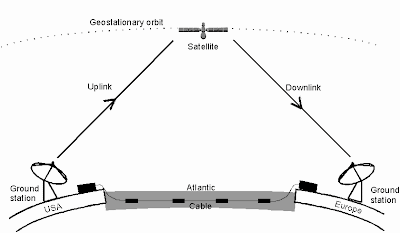Moon is a natural satellite of earth. However we are not interested in the natural satellites. We want to learn something different about the artificial (man made) satellites.
An artificial satellite orbits or revolves around the earth in exactly the same manner as electrons revolve around the nucleus of an atom. The path in which satellites move are call as orbits. The orbits are of different types such as synchronous orbits, polar orbits and inclined orbits, out of which the synchronous or geostationary orbit is used by the geostationary satellites. The geostationary satellites take exactly 24 hours to complete one revolution around the earth, therefore they appear to be stationary.
The satellites can be used for variety of purposes. Depending on the type of application, the satellites are classified into the following categories:
1.Communication Satellites
2.Remote sensing Satellites
3.Weather Satellites
4.Scientific Satellites
A geostationary communication satellite is basically a relay station in space. It receives signal from one earth station, amplifies it, improves the signal quality and radiate the signal back to other earth stations. Such a relay system allows us to communicate with any corner of the world.
Block Diagram of a Satellite Communication System
2.Ku band : 11/14 GHz
3.Ka band : 20/30 GHz
The C band frequencies of 4/6 GHz indicate that the down-link frequency is 4 GHz while
the up-link frequency is 6 GHz. One of the advantages of operating at such a high
frequency is reduction in the size of antennas and other components of the system.
- The block diagram of a satellite communication system is shown in above fig.
- An earth station transmits information signal to the satellite using a highly directional dish antenna.
- The satellite receives this signal, processes it and transmits it back at a reduced frequency.
- The receiving earth stations will receive this signal using parabolic dish antennas pointed towards the satellite.
- The signal which being transmitted upwards to the satellite is called as the "up-link" and it is normally at a frequency of 6 GHz.
- The signal which is transmitted back to the receiving earth station is called as the "down-link" and it is normally at a frequency of 4 GHz.
- Thus a satellite has to receive, process and transmit the signal. All these functions are performed by a unit called satellite transponder. A communication satellite generally has two sets of transponders, each set having 12 transponders making it a total of 24 transponders. Each transponder has a bandwidth of 36 MHz which is sufficient to handle at least one TV channel.
- The up-link signal received by a transponder is a weak and down-link signal transmitted by the transponder is strong. Therefore to avoid interference between them, the up-link and down-link frequencies are selected to be of different value
- The operation of satellite takes place at a very high signal frequencies in the microwave range. The typical band of signal frequencies used for the communication satellites are as follows:
2.Ku band : 11/14 GHz
3.Ka band : 20/30 GHz
The C band frequencies of 4/6 GHz indicate that the down-link frequency is 4 GHz while
the up-link frequency is 6 GHz. One of the advantages of operating at such a high
frequency is reduction in the size of antennas and other components of the system.
- It is extremely important to maintain the position of the satellite with respect to earth. Therefore control routines such as station keeping and altitude control are executed from the control room in the earth stations.
- Multiple access methods such as FDMA (frequency division multiple access), TDMA (time division multiple access) and CDMA (code division multiple access) are used to allow the access of a satellite to the maximum number of earth stations.
- The power requirement of a satellite is satisfied by solar panels and a set of nickel cadmium batteries, carried by the satellite itself.
Geostationary (GEO) Satellite
The satellites orbiting in the geostationary orbit are called geostationary satellites. They travel at the velocity of revolution of earth, hence complete one revolution around the earth in oner day i.e. 24 hours. This is the reason why geostationary satellites appear to be stationary.
The geostationary satellites are also called as GEO satellites.They are basically used for communication applications.
These satellites are at about 36000 km above the earth's surface. There are certain advantages of such a high altitude such as:
The geostationary satellites are also called as GEO satellites.They are basically used for communication applications.
These satellites are at about 36000 km above the earth's surface. There are certain advantages of such a high altitude such as:
- They are much above the inner radiation belt which posed problems to the solar cells of low altitude satellites.

- The solar cells get the solar radiation for almost 99% of the orbital period. Therefore energy storage is not necessary.
- The earth's magnetic field is weak at such heights. Therefore the adverse effects of magnetic field are absent.
- Large coverage area. A geostationary satellite is visible from about 42% of the earth's surface area. Therefore three communication satellites can cover the entire surface area of the earth as shown in the fig.
Complete coverage of earth's surface form 3 satelllites
The geostationary satellites are mostly used as communication satelllites. The earth stations which transmit and receive information from these satellites are relatively simple and low cost.

No comments:
Post a Comment